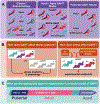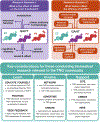Centering the Needs of Transgender, Nonbinary, and Gender-Diverse Populations in Neuroendocrine Models of Gender-Affirming Hormone Therapy
- PMID: 35863692
- PMCID: PMC10472479
- DOI: 10.1016/j.bpsc.2022.07.002
Centering the Needs of Transgender, Nonbinary, and Gender-Diverse Populations in Neuroendocrine Models of Gender-Affirming Hormone Therapy
Abstract
Most studies attempting to address the health care needs of the millions of transgender, nonbinary, and/or gender-diverse (TNG) individuals rely on human subjects, overlooking the benefits of translational research in animal models. Researchers have identified many ways in which gonadal steroid hormones regulate neuronal gene expression, connectivity, activity, and function across the brain to control behavior. However, these discoveries primarily benefit cisgender populations. Research into the effects of exogenous hormones such as estradiol, testosterone, and progesterone has a direct translational benefit for TNG individuals on gender-affirming hormone therapies (GAHTs). Despite this potential, endocrinological health care for TNG individuals remains largely unimproved. Here, we outline important areas of translational research that could address the unique health care needs of TNG individuals on GAHT. We highlight key biomedical questions regarding GAHT that can be investigated using animal models. We discuss how contemporary research fails to address the needs of GAHT users and identify equitable practices for cisgender scientists engaging with this work. We conclude that if necessary and important steps are taken to address these issues, translational research on GAHTs will greatly benefit the health care outcomes of TNG people.
Keywords: Hormones; Metabolism; Mood; Social behavior; Stress; Transgender.
Copyright © 2022 Society of Biological Psychiatry. Published by Elsevier Inc. All rights reserved.
Conflict of interest statement
The authors reported no biomedical financial interests or potential conflicts of interest.
Figures



Similar articles
-
Depressing time: Waiting, melancholia, and the psychoanalytic practice of care.In: Kirtsoglou E, Simpson B, editors. The Time of Anthropology: Studies of Contemporary Chronopolitics. Abingdon: Routledge; 2020. Chapter 5. In: Kirtsoglou E, Simpson B, editors. The Time of Anthropology: Studies of Contemporary Chronopolitics. Abingdon: Routledge; 2020. Chapter 5. PMID: 36137063 Free Books & Documents. Review.
-
Unlocking data: Decision-maker perspectives on cross-sectoral data sharing and linkage as part of a whole-systems approach to public health policy and practice.Public Health Res (Southampt). 2024 Nov 20:1-30. doi: 10.3310/KYTW2173. Online ahead of print. Public Health Res (Southampt). 2024. PMID: 39582242
-
Using Experience Sampling Methodology to Capture Disclosure Opportunities for Autistic Adults.Autism Adulthood. 2023 Dec 1;5(4):389-400. doi: 10.1089/aut.2022.0090. Epub 2023 Dec 12. Autism Adulthood. 2023. PMID: 38116059 Free PMC article.
-
"It Is a Big Spider Web of Things": Sensory Experiences of Autistic Adults in Public Spaces.Autism Adulthood. 2023 Dec 1;5(4):411-422. doi: 10.1089/aut.2022.0024. Epub 2023 Dec 12. Autism Adulthood. 2023. PMID: 38116051 Free PMC article.
-
Psychopharmacological Considerations for Gender-Affirming Hormone Therapy.Harv Rev Psychiatry. 2023 Jul-Aug 01;31(4):183-194. doi: 10.1097/HRP.0000000000000373. Harv Rev Psychiatry. 2023. PMID: 37437250 Free PMC article. Review.
Cited by
-
Sex diversity in the 21st century: Concepts, frameworks, and approaches for the future of neuroendocrinology.Horm Behav. 2024 Jan;157:105445. doi: 10.1016/j.yhbeh.2023.105445. Epub 2023 Nov 17. Horm Behav. 2024. PMID: 37979209 Free PMC article.
-
Epigenetic mechanisms underlying sex differences in the brain and behavior.Trends Neurosci. 2024 Jan;47(1):18-35. doi: 10.1016/j.tins.2023.09.007. Epub 2023 Nov 15. Trends Neurosci. 2024. PMID: 37968206 Free PMC article. Review.
-
Using Animal Models for Gender-Affirming Hormone Therapy.J Endocr Soc. 2023 Nov 20;8(1):bvad144. doi: 10.1210/jendso/bvad144. eCollection 2023 Dec 1. J Endocr Soc. 2023. PMID: 38090229 Free PMC article.
-
Perspective on equitable translational studies and clinical support for an unbiased inclusion of the LGBTQIA2S+community.Neuropsychopharmacology. 2023 May;48(6):852-856. doi: 10.1038/s41386-023-01558-8. Epub 2023 Mar 16. Neuropsychopharmacology. 2023. PMID: 36928352 Free PMC article. Review.
-
Diversity, Equity, and Inclusivity in Biological Psychiatry Research.Biol Psychiatry Cogn Neurosci Neuroimaging. 2022 Dec;7(12):1195-1197. doi: 10.1016/j.bpsc.2022.09.009. Biol Psychiatry Cogn Neurosci Neuroimaging. 2022. PMID: 36481057 Free PMC article. No abstract available.
References
-
- Goetz TG, Mamillapalli R, Devlin MJ, Robbins AE, Majidi-Zolbin M, Taylor HS (2017): Cross-sex testosterone therapy in ovariectomized mice: Addition of low-dose estrogen preserves bone architecture [published correction appears in Am J Physiol Endocrinol Metab. 2020; 319:E658]. Am J Physiol Endocrinol Metab 313:E540–E551. - PMC - PubMed
-
- Coleman E, Bockting W, Botzer M, Cohen-Kettenis P, DeCuypere G, Feldman J, et al. (2012): Standards of care for the health of trans-sexual, transgender, and gender-nonconforming people, Version 7. Int J Transgend 13:165–232.
-
- Green AE, DeChants JP, Price MN, Davis CK (2022): Association of gender-affirming hormone therapy with depression, thoughts of suicide, and attempted suicide among transgender and nonbinary youth. J Adolesc Health 70:643–649. - PubMed
Publication types
MeSH terms
Substances
Grants and funding
LinkOut - more resources
Full Text Sources
Medical

